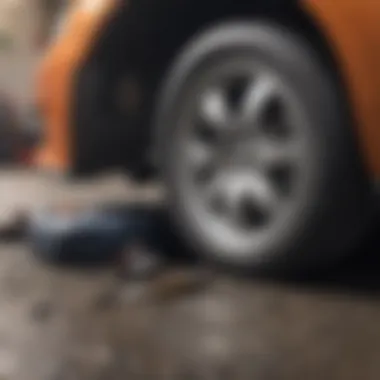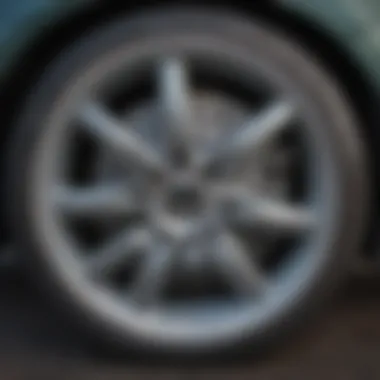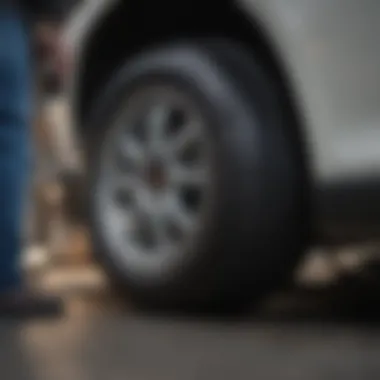Wheel Well Dent Repair: Expert Insights and Techniques


Intro
Wheel well dents may seem like a minor issue, but they can lead to more significant problems if left unaddressed. Understanding the repair process is essential for vehicle owners. Several factors lead to dents in this area, including road debris, weather conditions, and minor collisions. Ignoring these dents can compromise both aesthetic appeal and functionality. This article will delve into the various aspects of wheel well dent repair, including causes, methods, costs, and long-term implications. Each section will provide you with the knowledge needed to make informed decisions regarding your vehicle's auto body integrity.
Causes of Wheel Well Dents
Understanding the causes is the first step in addressing wheel well dents. These imperfections can arise from several sources:
- Road debris: Small stones and gravel can cause dents when they are propelled against the vehicle.
- Accidental collision: Parking mishaps can lead to minor collisions with other vehicles or objects.
- Environmental factors: Over time, weather elements like hail can dent the metal in your wheel wells.
Each of these causes contributes to not only the surface appearance of the vehicle but also to possible underlying issues.
Repair Techniques
Repairing wheel well dents involves various methods, depending on the severity and location of the dent:
Paintless Dent Repair (PDR)
- Advantages: This method maintains the original paint and is usually faster and less expensive. PDR technicians access the inside of the panel and gently push the dent out.
- Applicability: Most effective for minor dents without paint damage.
Traditional Repair Methods
- Bondo applications: For more serious dents, body fillers can restore the shape of the wheel well. After applying the filler, sanding and repainting will be necessary.
- Panel replacement: If the damage is extensive, replacing the entire panel may be the only option.
When considering which method to pursue, evaluate the extent of the damage and your budget.
Cost Factors
Understanding the costs associated with wheel well dent repair can help in planning your repairs:
- Method used: Paintless dent repair is generally cheaper than traditional methods due to lower labor costs.
- Location of repair shop: Shops in urban areas may charge more than those in rural areas.
- Extent of damage: Larger or more complex repairs may incur higher costs.
It is advisable to get estimates from multiple repair facilities to ensure competitive pricing.
Long-Term Implications
Ignoring wheel well dents can have long-term effects:
- Rust formation: Dents can trap moisture, leading to rust that compromises the structural integrity of the vehicle.
- Decreased resale value: Cosmetic damage can negatively impact how much you can sell the car for later.
- Potential for further damage: A dent can lead to issues with misalignment or functional parts like the suspension if left unchecked.
Addressing wheel well dents promptly can save you money and heartache in the long run.
Closure
Understanding wheel well dent repair allows vehicle owners to make informed choices. From recognizing the causes to selecting the right repair methods and understanding potential costs, each point is critical in preserving vehicle integrity. This comprehensive guide aims to equip you with the knowledge necessary to effectively address any wheel well dents you may encounter.
Understanding Wheel Well Dents
Understanding the nature and implications of wheel well dents is crucial for car owners who wish to maintain their vehicles. Wheel well dents often stem from various causes, ranging from road conditions to accidents. Gaining insights into these dents can help create effective repair strategies. This section will cover definitions, common causes, and the overall importance of addressing wheel well dents.
Definition of Wheel Well Dents
Wheel well dents refer to depressions or indentations located in the area surrounding the wheel wells of vehicles. These dents can vary in size and depth, influenced by the severity of the impact or condition that caused them. Understanding this definition is important because it sets the stage for why repair is necessary. Dents in this area can affect not just the look of the vehicle but also possibly impact its functionality.
Common Causes
Identifying the common causes of wheel well dents allows for better prevention and repair insight. Here are a few notable contributors:
Road debris impacts
Road debris impacts are common culprits behind wheel well dents. Small rocks, branches, and other materials can get kicked up from road surfaces during driving, leading to significant damage. The primary characteristic here is the unpredictability of these debris. It is a significant topic, as understanding the pathway of these materials can help drivers avoid hazards when possible. Additionally, recognizing this cause can help in selecting suitable protective measures, like installing mud flaps.
Accidental collisions
Accidental collisions can cause direct impacts to the wheel well area. This can occur in parking lots, where drivers often misjudge distance, leading to contact with curbs or other vehicles. The key characteristic of this cause is its often preventable nature, making awareness and careful driving essential. The unique aspect of accidental collisions is that they usually leave visible marks. This makes it easier to attribute damage to specific incidents and address repair needs accordingly.
Environmental factors


Environmental factors can also lead to wheel well dents. Prolonged exposure to weather elements can weaken the paint and protective coverings of the vehicle. For example, hail can cause dents, while consistent moisture may contribute to rust formation. The uniqueness of environmental factors lies in their gradual effect, which means car owners may notice dents over time rather than immediately. Understanding this allows for timely interventions, avoiding extensive damage later on.
Understanding these causes helps individuals in developing strategies for both prevention and repair. Awareness of the risks will lead to better vehicle care.
In summary, a clear understanding of wheel well dents encompasses various definitions and causes, particularly road debris impacts, accidental collisions, and environmental factors. These insights form the foundation for effective repair techniques and preventive measures.
Impact of Wheel Well Dents
Understanding the impact of wheel well dents is crucial for any vehicle owner. These dents can be more than just a cosmetic issue; they can affect the overall functionality and longevity of your vehicle. Ignoring wheel well dents can lead to further complications down the line. Hence, grasping their implications helps in making informed decisions regarding repair or maintenance.
Aesthetic Concerns
Aesthetic concerns regarding wheel well dents are significant for many car owners. A dent around the wheel well can detract from the overall appearance of a vehicle. For some individuals, the visual appeal and condition of their car reflect personal pride. A car with visible dents may be perceived as neglected or poorly maintained. This perception can impact not just one’s enjoyment of the vehicle, but also its resale value.
Impact on Vehicle Functionality
Effect on tires and suspension
The effect of wheel well dents on tires and suspension can be profound. Dents can alter the alignment of the wheel well, affecting the positioning of tires. This misalignment can lead to uneven tire wear, reducing their lifespan. Additionally, if the suspension components are compromised due to the dent's impact, it can result in a stiffer ride or even cause premature failure of suspension parts. Addressing these dents is essential to maintain proper tire health and suspension performance.
Potential for rust and corrosion
There is a notable potential for rust and corrosion associated with wheel well dents. Dents can create gaps in the vehicle's protective coating, exposing raw metal to moisture and debris. This condition increases the likelihood of rust developing over time. Rust not only compromises the structural integrity of the vehicle but can also lead to costly repairs if left unchecked. Recognizing this risk reinforces the importance of timely dent repair as part of vehicle maintenance.
DIY Wheel Well Dent Repair Techniques
Wheel well dent repair can seem daunting, but understanding DIY techniques allows car owners to take charge of their vehicle maintenance. Engaging in these repair techniques not only saves money but also empowers individuals to address issues promptly. This section focuses on the essential tools and a straightforward step-by-step process for effective dent repairs, providing a practical approach for those willing to take on the task.
Tool Requirements
Before proceeding with any repair, it's crucial to gather the right tools. Commonly needed tools include:
- Heat gun or hair dryer: This helps soften the metal, making it more malleable for dent removal.
- Pliers: These assist in pulling the dented area back into shape.
- Suction cup tools: These are effective for pulling out the dent.
- Denture cleaning tablets: They can be used to clean any residual marks after repair.
- Rubbing compound: This helps polish the area after the dent has been fixed.
Having the proper tools ensures a smoother repair process and increases the chances of achieving satisfactory results.
Step-by-Step Repair Process
Assessing damage severity
Assessing damage severity is the first crucial step before attempting any repair. This involves examining the dent's size, depth, and location. A minor dent is often easier to repair, whereas deeper or larger dents might require more specialized techniques or even professional help.
Understanding the damage helps in deciding the most effective method. Not all dents are the same and judging the severity early on avoids further complications.
- Quick evaluation can save time.
- Helps a person to choose the right repair technique.
Using heat application
Using heat application is a widely accepted method in DIY dent repairs. Heat allows the metal to expand, making it easier to manipulate the dent back into place. This approach is effective for metal that can withstand heat without resulting in further damage.
A hair dryer can be used to apply heat evenly. However, caution is necessary to avoid overheating, as it may cause the paint to warp or crack.
- Beneficial for shallow dents.
- Easy to execute with minimal risk if done correctly.
Utilizing suction tools
Utilizing suction tools can deliver impressive results for certain types of dents. These tools create a vacuum that pulls the dent outward by attaching directly to the bulge.
Suction devices work effectively on smooth, flat surfaces and are a popular choice among DIYers. However, they require a proper seal to be effective and can sometimes cause damage if not used carefully.
- Quick process that yields immediate results.
- May not work well on all dent shapes.
DIY repair can be a practical solution for minor wheel well dents. However, if the damage exceeds your capabilities, don't hesitate to consult professionals.
Professional Wheel Well Dent Repair Options
Addressing wheel well dents effectively often leads individuals to seek professional help. This option is crucial as it can ensure a level of quality and expertise that DIY efforts may lack. Professional repair options generally utilize specific techniques that cater to the unique characteristics of wheel well dents. Choosing to work with professionals can save time and potentially lower the overall repair costs by preventing additional damages.
Types of Professional Services


Paintless dent repair
Paintless dent repair is a popular choice among vehicle owners who want to maintain the original finish of their vehicles. This method focuses on gently massaging the dent out from behind the panel without the need for painting or body filler. It is beneficial for small to medium-sized dents and can be completed relatively quickly.
The key characteristic of paintless dent repair is its non-invasive approach. This is why it appeals to many. The process retains the factory paint, which can help preserve the vehicle's resale value. However, it may not be suitable for all dent types, particularly those that are sharp or located on the edges of panels.
Traditional bodywork
Traditional bodywork offers a more thorough repair method for deep and complex dents. This technique involves filling in the dent with body filler before repainting the area. It can restore the vehicle to its original condition but often requires more time and expertise.
The defining feature of traditional bodywork is its versatility. It can address a range of damage types, from simple dents to extensive repairs. One disadvantage is the time involved and the potential for mismatched paint, which can affect the overall aesthetic of the vehicle.
Selecting a Repair Shop
Choosing the right repair shop is essential to ensure quality work and customer satisfaction. The right professional can greatly influence the outcome of the repair process.
Evaluating credentials
Evaluating the credentials of a repair shop can reveal a lot about its quality and trustworthiness. Look for certifications that indicate the shop's technicians have received training in specific repair methods, such as paintless dent repair. A shop with strong credentials is often regarded as a safer choice for services.
Unique features of adhering to credentials include the assurance that the staff is knowledgeable in best practices and modern techniques. However, overly focusing on credentials alone may overlook the shop's overall reputation.
Checking reviews and recommendations
Checking reviews and recommendations from past customers helps gauge the quality of service offered by a repair shop. Platforms like Reddit or Facebook can provide insights into customer experiences. High ratings and positive comments often indicate reliable service and skilled technicians.
What makes this approach significant is the direct feedback from individuals who have undergone similar experiences. It can also highlight areas where the shop excels or may fall short. However, always consider the context of reviews, as every individual's experience may differ.
Cost Considerations for Wheel Well Dent Repair
Understanding the costs associated with wheel well dent repair is crucial for vehicle owners. It helps in budgeting effectively and making informed decisions whether to go for a DIY approach or seek professional services. We will explore the different facets of costs involved, including material expenses and labor charges, while also assessing how insurance impacts these costs.
DIY vs. Professional Costs
When it comes to wheel well dent repair, understanding the distinction between DIY and professional options is key. Both approaches have their unique financial implications, affecting overall expenses.
Material costs
Material costs play a significant role in any repair process. For DIY repairs, these might include tools like suction cups, heat guns, and specific dent repair kits. Pros often use specialized materials which can contribute to a higher overall charge for services. The advantage of tackling the task yourself is the potential savings on these costs. However, it is important to remember that lower material costs might lead to subpar results without the proper skillset or experience.
In this respect, opting for reputable brands might yield more effective tools, bringing quality along with usefulness in material procurement. While splurging might be tempting, manufacturers often provide detailed instructions that can enhance success rates in DIY repairs.
Labor costs
Labor costs structure the foundation of professional services. Technicians often charge based on their expertise and the complexity of the dent. While you have the option to attempt repairs, knowing how much a professional might charge can influence your decision. Fortunately, many shops provide estimates that help clarify expected expenses.
This can serve as a benchmark in understanding whether it is worth investing that money or taking the DIY route. Another consideration is time – professional technicians usually complete repairs faster than a typical DIY approach would allow. Therefore, labor costs not only reflect the financial expenditure but also time efficiency, which can be a vital factor for many vehicle owners.
Insurance Implications
Navigating insurance coverage is another critical element in the cost landscape of wheel well dent repair. Understanding what your insurance covers can significantly impact your overall costs.
Coverage options
When it comes to coverage options, policies may vary widely. Some insurance companies might cover full costs depending on the severity and nature of the damage, while others may only cover specific aspects such as collision damages. Familiarizing yourself with your individual policy details can provide clarity and help you decide whether it is financially prudent to make a claim.
Many vehicle owners overlook this aspect, potentially missing out on reductions in their out-of-pocket expenses. Ensuring to read the fine print about coverage can yield favorable outcomes in managing repair costs.
Deductibles
Deductibles are a significant factor in determining how much you will ultimately pay in the event of a claim. This is the amount that you, as the policyholder, are required to pay before insurance covers the remaining costs. The higher your deductible, the less your insurance can help in managing repair expenses. Conversely, lower deductibles can ease the financial burden during repairs but may lead to higher premiums.
Understanding this aspect helps you to make a more informed decision when considering whether to file an insurance claim for wheel well dents.
In summary, comprehending the cost considerations related to wheel well dent repair enables vehicle owners to make wise financial decisions.
By evaluating material and labor costs vs insurance implications, one can reflect on their unique circumstances and choose the best path forward. Overall, being knowledgeable about these issues enhances the chances of maintaining your vehicle’s integrity without incurring unexpected expenses.


Preventive Measures Against Wheel Well Dents
Implementing preventive measures against wheel well dents is essential in maintaining the aesthetics and functionality of a vehicle. It not only saves motorists from potential repair costs later but also preserves the value of their vehicle. Awareness of common causes and taking proactive steps can significantly reduce the likelihood of developing dents in the wheel well area. Here are some effective measures to consider:
Routine Vehicle Maintenance
Routine vehicle maintenance plays a crucial role in preventing wheel well dents. Regular inspections help to identify any vulnerabilities that may expose a vehicle to damage. Tasks like checking tire conditions ensure that your vehicle is less prone to accidents caused by tire blowouts or improper alignments.
Additionally, maintaining proper tire pressure is critical. Underinflated tires can cause swaying, making your vehicle more susceptible to hitting curbs or other objects. Regular washing, especially during winter months, ensures that road salt and debris do not accumulate. These can lead to corrosion, increasing the damage potential when minor impacts occur.
Overall, committing to periodic maintenance can enhance the longevity of the vehicle and minimize unexpected expenses.
Protective Gear and Accessories
Using protective gear and accessories is another effective way to prevent wheel well dents. Investing in the right tools can result in long-term savings and a smoother ride.
Wheel Well Liners
Wheel well liners are crucial for safeguarding the wheel well area from debris and moisture. They act as a barrier against road elements that can cause dents or corrosion. One key characteristic of wheel well liners is their ability to absorb impacts, which reduces the risk of damage significantly. They are particularly beneficial for off-road vehicles or those frequently driven on rough terrain.
These liners come in various materials, like rubber or plastic, allowing consumers to choose based on their preferences. Rubber liners, for example, offer flexibility and strong protection against dirt, whereas plastic options might have higher durability against harsh weather conditions. However, it’s wise to consider that liners may require regular checking and replacing due to wear over time.
Protective Coatings
Protective coatings serve as another layer of defense against potential dents and rust. These coatings can be applied to the wheel well area, providing a shield against moisture and salts that cause corrosion. A significant characteristic of protective coatings is their ability to create a waterproof seal.
They are often popular among vehicle owners who wish to extend their car's life, especially in regions with extreme weather. However, one unique feature is that some coatings can become less effective over time, requiring reapplication. Choosing the right product and researching its longevity can ensure optimal protection.
Properly maintaining your vehicle and using protective accessories can lead to significant long-term cost savings by minimizing the risks of dents.
In summary, preventive measures are beneficial not only for preserving the vehicle's aesthetics but also for ensuring its overall functionality and value.
Long-Term Considerations Following Repair
Long-term considerations are crucial in the realm of wheel well dent repair. After fixing these dents, it is vital to think beyond the immediate aesthetic improvements. Understanding the implications of your repair choices can ensure the vehicle's longevity and integrity. This section delves into warranty and service guarantees, along with monitoring for any potential recurrence of damage.
Warranty and Service Guarantees
When choosing a repair service, inquire about warranties. A solid warranty indicates the repair shop's confidence in its work. Typically, warranties can last from a few months up to several years.
Benefits of a good warranty include:
- Coverage for Future Repairs: If the same issue arises during the warranty period, the repair may be done at no additional cost.
- Quality Assurance: Reliable technicians are likely to provide quality work guaranteed.
- Peace of Mind: Clients can feel reassured knowing their investment is protected.
Some warranties may exclude certain conditions. Always read the fine print to understand what is covered and any additional requirements needed to maintain warranty validity.
Monitoring for Recurrence of Damage
After repairs, it is essential to monitor the wheel well area for possible signs of damage returning. Regular checks can help identify issues early on, preventing extensive repairs later. A few considerations include:
- Inspect Regularly: Check the wheel well areas for scratches, dents, or signs of rust at least once a month.
- Report Anomalies Immediately: If new dents appear or if any unusual sounds arise when driving, seeking professional advice is wise.
- Keep It Clean: Washing your vehicle regularly helps keep debris from accumulating, which can lead to further damage over time.
Regular inspections can save you from larger repair costs down the road.
End
The conclusion serves as a crucial component of this article, encapsulating the main ideas discussed throughout. Understanding wheel well dent repair is essential for any car owner who values the integrity and appearance of their vehicle. We have explored various aspects ranging from the definition of wheel well dents to their impact on vehicle functionality and aesthetics.
This guide provided a comprehensive overview of DIY and professional repair options. Each method has its advantages and potential pitfalls, making informed decision making vital. The cost considerations, including material and labor costs, are also significant factors that influence whether to undertake repairs independently or hire a professional service.
Furthermore, preventive measures are equally important. Adhering to routine vehicle maintenance can significantly reduce the likelihood of future damages. The article also emphasizes the importance of warranties and service guarantees post-repair, ensuring that car owners have peace of mind regarding their investment.
Thus, having a thorough understanding of the nuances involved in wheel well dent repair not only saves time and money but also enhances the longevity and appearance of your vehicle.
Summary of Key Points
- Wheel well dents can arise from various causes: road debris, collisions, or environmental factors.
- Ignoring wheel well dents can lead to aesthetic issues and potential damage to vehicle functionality.
- DIY repair is feasible with the right tools and techniques, but professional services provide expertise and reassurance.
- Costs vary widely, and insurance implications can influence repair decisions.
- Preventive maintenance and protective accessories play a vital role in minimizing future dent occurrences.
- Post-repair monitoring and understanding warranties are key for long-term vehicle care.
Final Recommendations
To maintain your vehicle's integrity and value, it is recommended to assess any wheel well dent promptly. If the damage is minor, consider DIY methods. However, for more significant dents or if uncertain, professional repair services might be wise. Make sure to choose a reputable repair shop by evaluating credentials and gathering reviews.
It's also beneficial to invest in protective measures and have a routine maintenance schedule. In doing so, you not only address existing issues but also prevent future complications that could arise from neglect. Lastly, keep documentation of repairs and warranties organized for reference, ensuring you are covered for any unexpected repair needs.
"Regular vehicle care is an investment into the longevity and performance of your car."







